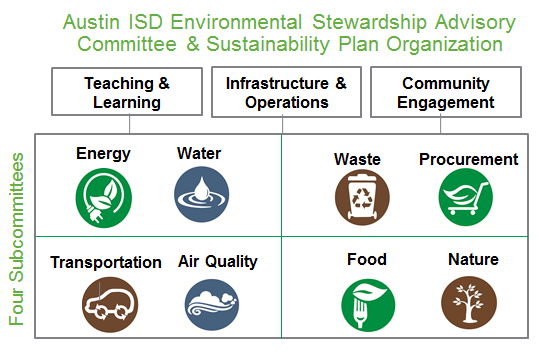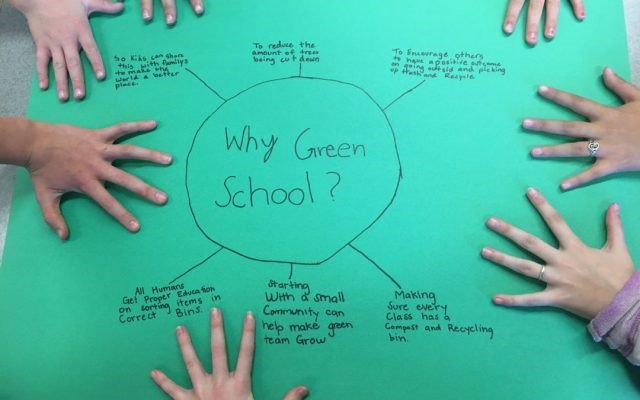In a city whose motto is “Keep Austin Weird” and a state where barbeque and college football rule, Austin Independent School District (AISD) teachers, students, administrators, and community members are taking sustainability by the horns with an innovative whole-school sustainability approach. An approach that, beyond a paradigm shift in teaching and learning, also helps the city tackle some of its biggest challenges related to traffic congestion, air quality, waste diversion, energy and water conservation and urban greenspace.
The History of Sustainability at Austin Independent School District
The sustainability movement at AISD was initiated while planning for the 2004 Bond Program with the leadership of Austin ISD Board member, Vincent Torres; Executive Director of Facilities, Paul Turner; Director of Construction Management, Curt Shaw; and members of the vibrant Austin environmental community. Turner explains why the district embarked on this journey initially, "Green building practices help provide learning environments that are more appealing, healthful, and over the life of the building, more fiscally responsible. The Austin community, especially the environmental community, expects its public school district to provide leadership in support of environmental stewardship, and the implementation of green building standards will be a first step in a process to create a culture of sustainability in the Austin ISD."
In order to clarify its commitment, AISD Facilities and Construction Management departments partnered with the Austin Energy Green Building Program to set a goal that all new schools would achieve at least a two star rating on the Austin Energy Green Building Assessment, and all major renovations would adhere to green building standards.
Concurrently, a partnership was established between the AISD Facilities and Science Departments. David Guffey, Administrative Supervisor of Science at the time and Paul Turner felt it was important to help students who already studied principles of environmental stewardship in their science and social studies coursework to understand the larger context and importance of environmental stewardship and how to engage in its practice in their daily lives.
When asked how the district's environmental stewardship committee got its start, Turner explained, "David and I felt that forming an Environmental Stewardship Envisioning Committee could provide a vehicle for developing the infrastructure necessary to help students make connections and realize the vision of integration of the principles in their lives." In 2008, Turner and Guffey organized and launched the committee. The membership consisted of interested students, teachers, parents, community members, administrative staff and city representatives that shared the goal to build a framework for environmental stewardship with representation throughout the organization, on school campuses, and among interested community members.
In response to the recommendations put forth from the committee, the Board of Trustees adopted a 2010 Resolution and 2011 Environmental Sustainability Policy that solidified district-level support for “sustainability as an economic, environmental and social priority to be taught and practiced throughout the District.”
In 2013, the group became an official district advisory body, and now operates as the Environmental Stewardship Advisory Committee (ESAC). The first dedicated sustainability staff member was hired in 2014, and current ESAC membership includes over 30 members with representation from parents, teachers, non-teaching staff, businesses, local government and the larger community.
Gina LaMotte, Founder and Executive Director of EcoRise Youth Innovations reflects on the holistic approach to Sustainability at Austin ISD. “Having served as a Co-Chair for Austin ISD’s Environmental Stewardship Advisory Committee in its early days, I can tell you that the work of greening a school district is complicated and messy. With so many stakeholders, a million competing priorities and amazing projects happening in quiet corners across the district, it is difficult to build a common vision, get a handle on the facts and mobilize a team. This is where the Whole-School Sustainability Framework can help – by offering a mental model and common language to organize around.” With the Whole-School Sustainability Framework in mind, the ESAC and AISD sustainability staff began to craft the District’s first-ever Sustainability Plan.
What’s in a Sustainability Plan?
The ESAC self-organized into 4 subcommittees to develop goals and strategies in the following action areas that would shape the sustainability plan: Energy & Water, Waste & Procurement, Transportation & Air Quality and Food & Nature. Members were challenged to identify strategies for each action area that addressed Teaching & Learning, Infrastructure & Operations, and Community Engagement. At present, the sustainability plan contains over 24 goals and 100 strategies and is in its final stages of development. To help prioritize, each strategy was evaluated according to cost, impact, and effort. Indicating whether a strategy was not started, in progress or complete revealed that a handful of the strategies were already underway. This has helped not only with planning, but has served as a quick reference for teachers, administrators, community groups and the district’s internal marketing team to know what initiatives are taking place across all action areas. Public input at community meetings and online surveys will also add another layer of information about what the larger community would like to see regarding district sustainability initiatives. A few characteristics that contribute to the comprehensive and unique approach to the sustainability plan are considered in this diagram.
the larger community would like to see regarding district sustainability initiatives. A few characteristics that contribute to the comprehensive and unique approach to the sustainability plan are considered in this diagram.
Aligning Sustainability Goals Across Agencies
The inclusion of members from various parts of the community in the ESAC ensures that goals and strategies not only benefit the school district and students, but also help the larger community and partner organizations achieve their goals as well. According to LaMotte, “EcoRise has been working with Austin ISD for the last eight years and we have witnessed incredible growth and leadership in its commitment to green schools - across all three pillars of Whole School Sustainability. Within the scope of our work, we mainly fall into the educational programming pillar, which cultivates students’ eco-literacy and healthy, sustainable behaviors through curriculum and real-world problem-solving. However, our students have also led hundreds of green campus improvement projects (supporting the physical place pillar) and stand as proud champions of sustainability, influencing the school’s organizational culture”
Further, the City of Austin has a Zero Waste Goal of achieving 90 percent landfill waste diversion by 2040. Including city staff and subject-matter experts in the ESAC ensures that waste diversion strategies for the district are in line with the city’s goals and timeline. Traffic congestion and air quality are also large concerns for Austin, and stakeholders with knowledge in this area have enabled the city’s Mobility Goal to cut peak traffic by 20 percent by 2020 to be incorporated into the district’s sustainability plan. The sustainability planning process has also embraced input from additional ESAC members whose organizations’ goals include increasing urban tree canopy and access to nature, facilitating access to fruits and vegetables in urban food-deserts, improving water quality through green storm water infrastructure, improving energy efficiencies in the built environment, conserving local pollinator populations, and integrating project-based learning into curriculum. With consideration to align goals from a variety of agencies, the sustainability plan has become an organized approach for the city, the school district, and partner organizations to move the needle together.
Equity Lens
As strategies were developed for the sustainability plan, an opportunity to embed equity into all action areas emerged. At present, ESAC members and AISD Sustainability staff are evaluating each strategy and adding actions that directly address equity. For example, actions to increase student access and experience in nature include an evaluation of Austin ISD’s outdoor learning infrastructure (gardens, habitat, outdoor classrooms, etc.). This data will be mapped and then overlaid with the city’s data of nature-deficient communities of Austin. The sustainability plan then includes an action to implement targeted programming to schools that lack learning-in-nature spaces and that are in nature-deficient parts of Austin. This model is already in effect with the Cities Connecting Children to Nature pilot program at Barrington Elementary School.
Student Engagement
Perhaps one of the most rewarding parts of integrating sustainability into a school district is the opportunities to build excitement and capacity in our youth to address real-world challenges through a holistic lens. The inclusion of strategies for teaching and learning in the sustainability plan provides a way for students to directly contribute to achieving the district’s sustainability goals. In this aspect, the schools become “living labs” where student initiatives such as school composting, paper waste reduction, gardens, energy audits, rainwater capture and no-idling campaigns serve as tools for project-based learning while advancing sustainability at Austin ISD.
As LaMotte states, “I suppose it will not come as surprise when I say that I strongly believe that the most effective and exciting strategy for driving sustainability in a school district is by handing much of the job over to our students! Forward-thinking districts, such as Austin ISD, can champion the ethos of sustainability. They can provide the right investments, grant permissions and build the infrastructure to support this movement…. but the real opportunity lies in the power of our world’s largest untapped resource, our students. Can you imagine a more engaging and rigorous classroom assignment than one which challenges students to build a district-wide strategy, mobilize an entire community and save the world?”











